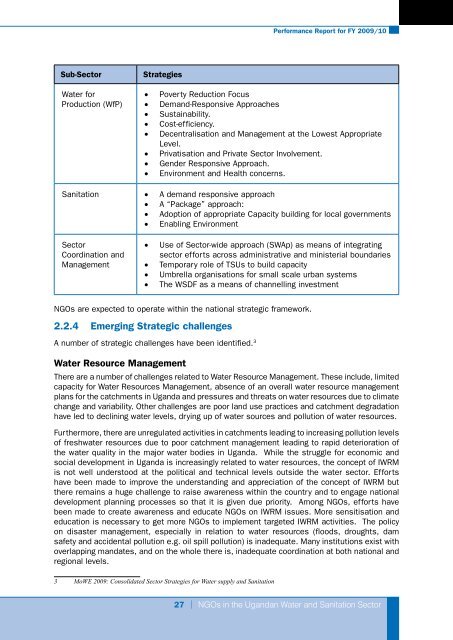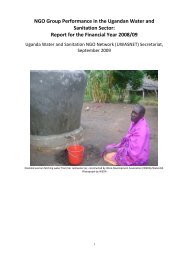Performance Report for FY 2009/10 - UWASNET
Performance Report for FY 2009/10 - UWASNET
Performance Report for FY 2009/10 - UWASNET
You also want an ePaper? Increase the reach of your titles
YUMPU automatically turns print PDFs into web optimized ePapers that Google loves.
Sub-Sector Strategies<br />
Water <strong>for</strong><br />
Production (WfP)<br />
<strong>Per<strong>for</strong>mance</strong> <strong>Report</strong> <strong>for</strong> <strong>FY</strong> <strong>2009</strong>/<strong>10</strong><br />
• Poverty Reduction Focus<br />
• Demand-Responsive Approaches<br />
• Sustainability.<br />
• Cost-efficiency.<br />
• Decentralisation and Management at the Lowest Appropriate<br />
Level.<br />
• Privatisation and Private Sector Involvement.<br />
• Gender Responsive Approach.<br />
• Environment and Health concerns.<br />
Sanitation • A demand responsive approach<br />
• A “Package” approach:<br />
• Adoption of appropriate Capacity building <strong>for</strong> local governments<br />
• Enabling Environment<br />
Sector<br />
Coordination and<br />
Management<br />
• Use of Sector-wide approach (SWAp) as means of integrating<br />
sector ef<strong>for</strong>ts across administrative and ministerial boundaries<br />
• Temporary role of TSUs to build capacity<br />
• Umbrella organisations <strong>for</strong> small scale urban systems<br />
• The WSDF as a means of channelling investment<br />
NGOs are expected to operate within the national strategic framework.<br />
2.2.4 Emerging Strategic challenges<br />
A number of strategic challenges have been identified. 3<br />
Water Resource Management<br />
There are a number of challenges related to Water Resource Management. These include, limited<br />
capacity <strong>for</strong> Water Resources Management, absence of an overall water resource management<br />
plans <strong>for</strong> the catchments in Uganda and pressures and threats on water resources due to climate<br />
change and variability. Other challenges are poor land use practices and catchment degradation<br />
have led to declining water levels, drying up of water sources and pollution of water resources.<br />
Furthermore, there are unregulated activities in catchments leading to increasing pollution levels<br />
of freshwater resources due to poor catchment management leading to rapid deterioration of<br />
the water quality in the major water bodies in Uganda. While the struggle <strong>for</strong> economic and<br />
social development in Uganda is increasingly related to water resources, the concept of IWRM<br />
is not well understood at the political and technical levels outside the water sector. Ef<strong>for</strong>ts<br />
have been made to improve the understanding and appreciation of the concept of IWRM but<br />
there remains a huge challenge to raise awareness within the country and to engage national<br />
development planning processes so that it is given due priority. Among NGOs, ef<strong>for</strong>ts have<br />
been made to create awareness and educate NGOs on IWRM issues. More sensitisation and<br />
education is necessary to get more NGOs to implement targeted IWRM activities. The policy<br />
on disaster management, especially in relation to water resources (floods, droughts, dam<br />
safety and accidental pollution e.g. oil spill pollution) is inadequate. Many institutions exist with<br />
overlapping mandates, and on the whole there is, inadequate coordination at both national and<br />
regional levels.<br />
3 MoWE <strong>2009</strong>: Consolidated Sector Strategies <strong>for</strong> Water supply and Sanitation<br />
27 | NGOs in the Ugandan Water and Sanitation Sector



